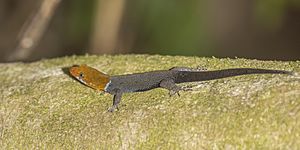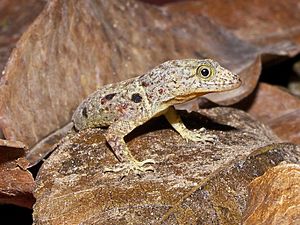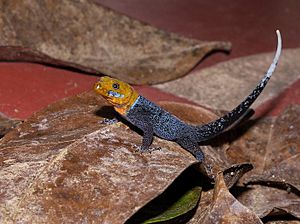Yellow-headed gecko facts for kids
Quick facts for kids Yellow-headed gecko |
|
|---|---|
 |
|
| Male G. a. fuscus, Panama | |
 |
|
| Female, Colombia | |
| Conservation status | |
| Scientific classification | |
| Genus: |
Gonatodes
|
| Species: |
albogularis
|
| Synonyms | |
|
Gymnodactylus albogularis Duméril and Bibron, 1836 |
|
The Gonatodes albogularis, often called the Yellow-headed gecko, is a small lizard. You can find it in warm parts of Central and South America, Cuba, Hispaniola, and Jamaica. These geckos like to live in tropical dry forests.
Males and females look different. This is called sexual dimorphism. Males are colorful with bright heads. Females are usually grey or brown. Unlike many geckos, they don't have sticky pads on their fingers for climbing smooth walls. Instead, they have normal claws like most lizards. Yellow-headed geckos can tell the difference between bright and dull colors. Males are very protective of their space. They will defend their territory from other males and even from animals that might try to eat them.
Contents
- About the Yellow-headed Gecko
- Names for the Yellow-headed Gecko
- What the Yellow-headed Gecko Looks Like
- Where Yellow-headed Geckos Live
- Reproduction and Life Cycle
- How Yellow-headed Geckos See
- Mating Behavior
- Predators and Defense
- Habitat and Daily Life
- Yellow-headed Geckos and People
- See also
- Images for kids
About the Yellow-headed Gecko
This gecko was first described by scientists in 1836. Its scientific name, albogularis, means "white-throated" in Latin. This name was chosen because the first geckos studied had very white throats.
Different Types of Yellow-headed Geckos
As of 2020, there are four main types, or subspecies, of the Yellow-headed gecko:
- Gonatodes albogularis albogularis
- Gonatodes albogularis bodinii
- Gonatodes albogularis fuscus
- Gonatodes albogularis notatus

Names for the Yellow-headed Gecko
In English, this gecko is often called the white-throated clawed gecko or white-throated gecko. The name yellow-headed gecko is also very common. In Venezuela, people call it mea-mea or machurito. In the Wayuu language, it's known as curumachár or culumasár. In Mexico, its official Spanish name is geco cabeza amarilla. Another Spanish name is limpiacasa. On the islands where Papiamento is spoken, it's called pega-pega.
What the Yellow-headed Gecko Looks Like
This gecko can grow to be about 6.9 to 9 centimeters (about 2.7 to 3.5 inches) long. Some can even reach 10 centimeters (about 4 inches).
As mentioned, males and females look different. Male geckos have colorful heads, often yellow or orange, and dark blue bodies. Female geckos are plainer, with greyish-white or light brown heads and bodies. These geckos have round pupils and no eyelids. Young geckos look like the females.
Males are usually a bit longer from their snout to the base of their tail. Both males and females can start having babies when they are about 6 months old. They can reproduce at any time of the year. Unlike some other lizards, these geckos don't store much fat in their bellies. This means their ability to reproduce isn't based on how much fat they have.
Yellow-headed geckos mostly eat insects and spiders. They are very territorial and will defend their space. They do this by waving their tails and other actions.
Similar Lizards

In the Lesser Antilles, you can tell this gecko apart from Gonatodes antillensis because its skin feels much rougher. The males of this species have darker bodies and a blue spot near their ear. Their pupils are always round.
Where Yellow-headed Geckos Live
Yellow-headed geckos are found in many places.
- Gonatodes albogularis albogularis
This type is found in the Lesser Antilles, northern Colombia, and Venezuela. It's also found on Aruba and Curaçao, where it was likely brought by humans. In the United States, this gecko was once common in Florida, especially Key West. It was first seen there in 1934.
- Gonatodes albogularis bodinii
This type is only found on the Los Monjes Archipelago islands in Venezuela.
- Gonatodes albogularis fuscus
This type lives in Nicaragua, Panama, Costa Rica, El Salvador, Cuba, and western Colombia. It was also found in Florida, especially around Miami and the Florida Keys. However, it seems to have died out in Florida by the mid-1990s.
- Gonatodes albogularis notatus
This type is found on the islands of Jamaica, Grand Cayman Island, Îlet à Cabrit, and Hispaniola (which includes Haiti and the Dominican Republic). It can live from sea level up to about 900 meters (3000 feet) high.
Yellow-headed geckos are also found in Mexico, Guatemala, and Honduras. It's not clear which specific type these geckos belong to.
Reproduction and Life Cycle
Yellow-headed geckos often lay their eggs in shared spots. This helps more eggs hatch and protects them from animals that might eat them. Females can have several babies in a year. They don't have a special time of year for breeding.
Where They Lay Eggs
Females usually lay single eggs in tree trunks. However, in places like Costa Rica and Panama, they have been seen laying eggs together at the base of trees. These spots, along with tree branches, under rocks, and in leaf litter, are common places to find these lizards. Leaf litter is especially good for communal egg-laying. It helps keep the eggs moist, which is important during the dry season when eggs can dry out quickly. Hiding eggs in leaf litter also makes them harder for predators to find.
Number of Eggs
A female Yellow-headed gecko carries only one egg at a time. Even though they can reproduce all year, they lay fewer eggs from December to May, which is the dry season. They focus all their energy on making sure that one egg survives. The egg will hatch about 2 to 4 months after it's laid.
How Yellow-headed Geckos See
Yellow-headed geckos can tell the difference between bright and dull colors. This helps them choose a mate. Their eyes have a yellow lens. This yellow lens blocks certain types of light, which protects their eyes and helps them see colors clearly.
The colors on these geckos can be very bright. Brighter colors can make a male more attractive to females. Females prefer males with brighter colors. This means that being able to see different brightness levels directly affects which mate a female chooses. This ability is most useful when the geckos are close to each other.
Mating Behavior
Yellow-headed geckos show aggressive behaviors to protect their territory and to avoid predators. They also use their different colors to help them find a mate.
Male Interactions
Male geckos have many aggressive behaviors to defend their territory from other males and from predators. These behaviors include lowering their throats, doing "push-ups," waving their tails, waving their whole bodies, and biting. Males who are good at defending their territory show more of these aggressive behaviors, and they last longer.
A gecko might start with small movements, like just lowering its throat. If it feels more threatened, it will do stronger, more aggressive actions like push-ups or whole-body waving. These aggressive behaviors are usually strongest in the middle of the day. One idea is that they peak then because their predators are less active. This gives the gecko a chance to defend its home and look for mates.
Larger males are often more aggressive. They are also more likely to be dominant and have more success reproducing.
Finding a Mate
Females usually prefer males with brighter colors. However, very bright colors can also make males easier for predators to spot. Being less noticeable helps males survive, but it makes it harder to find a mate. Yellow males are a bit different. They are more likely to win against other males and are less likely to be caught by predators compared to red males. Their color also shows how dominant they are.
Predators and Defense
One animal that eats the Yellow-headed gecko is the Brown Vinesnake. Other predators include larger lizards, birds, and mammals.
Escape Behavior
To avoid being eaten, the Yellow-headed gecko can drop its tail if a predator grabs it. This is called autotomy. The gecko will only drop its tail if the danger of being caught is greater than the cost of losing its tail. Even though losing its tail helps it escape the first attack, it makes it harder to survive a second attack. After losing its tail, a gecko will be more careful. It won't let predators get as close because it doesn't have that extra protection. As the tail grows back, the gecko becomes less cautious.
Geckos will also stay closer to safe spots after losing their tail. This helps them escape faster. The distance a gecko lets a predator get before it runs away is called "flight initiation distance." If a gecko lets a predator get closer, it means it's less likely to run away quickly.
Temperature can also affect how a gecko escapes. In warm temperatures, geckos are more active. They might wait for a predator to get very close. This saves energy, which helps them stay healthy. Female geckos that are carrying eggs also change their escape behavior. They are heavier and move slower, so they might run away sooner or run further to find safety.
Habitat and Daily Life
Yellow-headed geckos eat insects. They are mostly active during the day, but they try to avoid direct sunlight. In Panama, studies show they might lay more eggs during the rainy season. They only lay one egg at a time.
This gecko prefers living in tropical dry forests and at the edges of forests. They also like places where humans live. In Haiti, they are often found near buildings. Because of this, they often come into areas where people are active and might interact with humans.
Yellow-headed Geckos and People
Years ago, people in the Antilles (Caribbean islands) were very afraid of the pega-pega. They believed that once it climbed on you, it would stick so tightly that it was almost impossible to remove. Some thought you had to burn it off with a cigarette or hot iron, or pour boiling water on it. Some even thought it was poisonous. Luckily, this old belief has mostly disappeared among younger generations today.
See also
 In Spanish: Geco cabeza amarilla para niños
In Spanish: Geco cabeza amarilla para niños
- Dwarf yellow-headed gecko
- Yellow-headed day gecko
Images for kids



